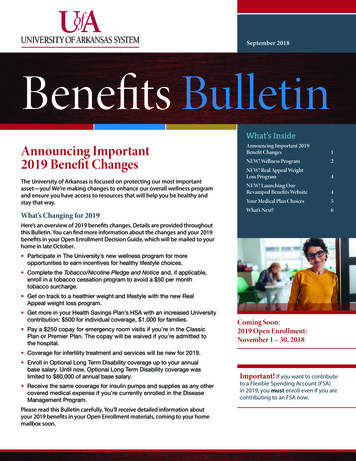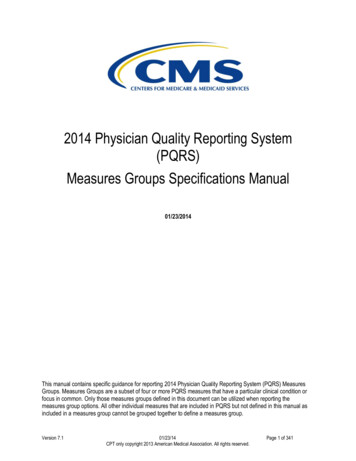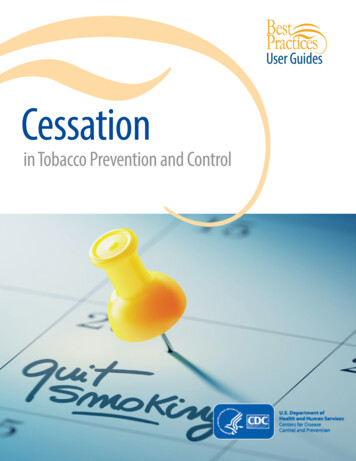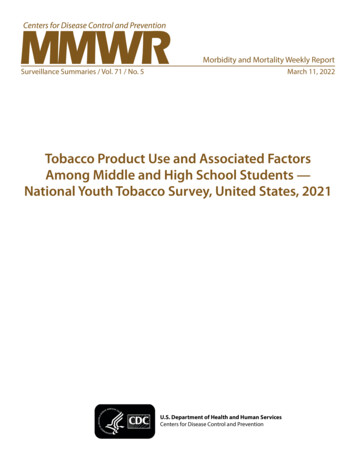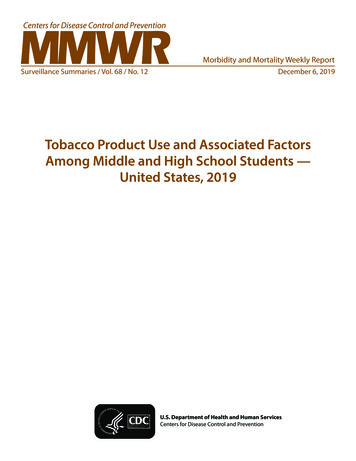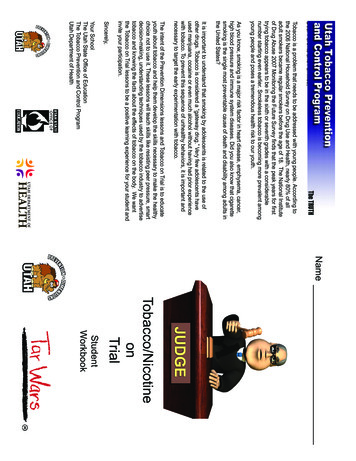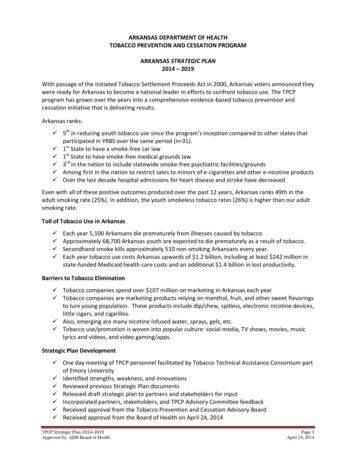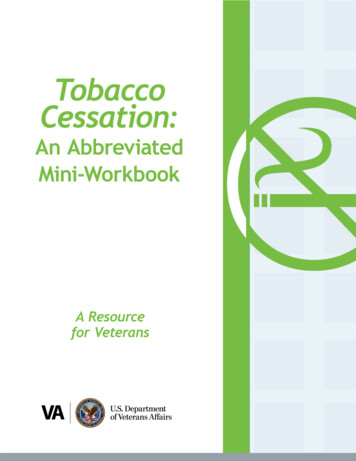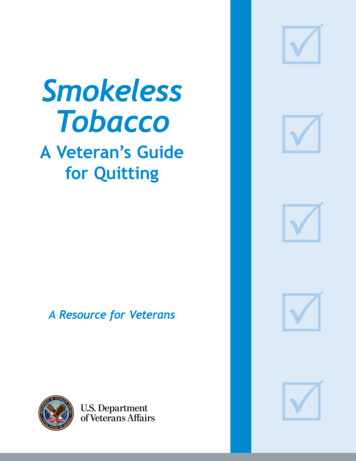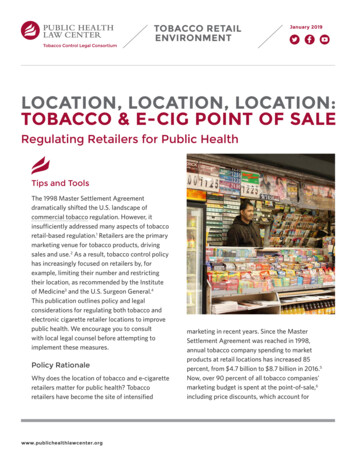
Transcription
TOBACCO RETAILENVIRONMENTJanuary 2019LOCATION, LOCATION, LOCATION:TOBACCO & E-CIG POINT OF SALERegulating Retailers for Public HealthTips and ToolsThe 1998 Master Settlement Agreementdramatically shifted the U.S. landscape ofcommercial tobacco regulation. However, itinsufficiently addressed many aspects of tobaccoretail-based regulation.1 Retailers are the primarymarketing venue for tobacco products, drivingsales and use.2 As a result, tobacco control policyhas increasingly focused on retailers by, forexample, limiting their number and restrictingtheir location, as recommended by the Instituteof Medicine3 and the U.S. Surgeon General.4This publication outlines policy and legalconsiderations for regulating both tobacco andelectronic cigarette retailer locations to improvepublic health. We encourage you to consultwith local legal counsel before attempting toimplement these measures.Policy RationaleWhy does the location of tobacco and e-cigaretteretailers matter for public health? Tobaccoretailers have become the site of intensifiedwww.publichealthlawcenter.orgPullquote here,pullquotegoes here,pullquote here,pullquotegoes here,pullquote here.marketing in recent years. Since the MasterSettlement Agreement was reached in 1998,annual tobacco company spending to marketproducts at retail locations has increased 85percent, from 4.7 billion to 8.7 billion in 2016.5Now, over 90 percent of all tobacco companies’marketing budget is spent at the point-of-sale,6including price discounts, which account for
January 2019two-thirds of all tobacco industry spending on cigarette advertising and promotions,7 and otherincentive programs.8 As a result, three out of every four tobacco retailers in the United Statesdisplays at least one tobacco product price promotion.9These point-of-sale tobacco promotions work. They increase impulse purchases amongsmokers and enhance the urge to purchase among recent quitters. They are also stronglyassociated with smoking initiation,10 particularly among youth,11 who make up the vast majorityof new users.12 Moreover, point-of-sale advertising is more common in neighborhoods thatare, on average, younger,13 more racially diverse, and lower income.14 These point-of-salepromotions are more common at tobacco retailers near schools and where teens are likely toshop.15 Convenience stores, for example, are popular among teenage shoppers16 and featuresignificantly more tobacco advertising and promotions compared to other stores.17Tobacco retailers are also often concentrated in communities at higher risk for adversehealth outcomes,18 including communities whose residents have lower incomes, greaterracial diversity, and lower educational attainment.19 Indeed, the tobacco industry targets itsretail outlet advertising to people from these communities by spending considerably moreon in-store tobacco advertising in racially diverse and low-income neighborhoods.20 Salesto minors, which occur 18 percent of the time,21 are also more common at tobacco retailerslocated in neighborhoods with a higher proportion of young and racial minority residents.22The location and density of tobacco retailers influences tobacco use among residents living inthose communities.23 More than 40 percent of U.S. teens live or attend school near a tobaccoretailer.24 Moreover, youth who live or attend school in neighborhoods with the highest densityof tobacco outlets or retail tobacco advertising have higher smoking rates compared toyouth who live or attend school in neighborhoods with fewer or no tobacco outlets.25 Youngadults living in neighborhoods with greater tobacco retail density initiate use of non-cigarettecombustible tobacco products (e.g., cigars, cigarillos, hookah) and experiment with cigarettesmore than young adults residing in neighborhoods with lower tobacco retail density.26 Andfor current adult smokers, living less than 500 meters from a tobacco retailer significantlydecreases their chances of quitting and remaining abstinent.27Similar trends are emerging with e-cigarettes.28 Between 2015 and 2017, e-cigarette retail salesincreased 70 percent (from 775 million to 1.3 billion),29 and jumped again from 2017 to 2018by 77 percent, which is largely attributed to the rapid uptake of JUUL.30 Some 11 million adultsuse e-cigarettes daily,31 but use has reached epidemic levels among youth and younger adults.32Between 2011 and 2015, e-cigarette use increased 900 percent among youth,33 and today 20percent of 18- to 29-year-olds use e-cigarettes regularly or occasionally.34 This marked uptakewww.publichealthlawcenter.orgLocation, Location, Location: Tobacco & E-Cig Point of Sale2
January 2019has been driven by a proliferation in flavored and menthol products,35 which youth and youngadults overwhelmingly prefer.36Advertising exposure is also a key factor, reducing concerns among teens about the harmsand addictiveness of e-cigarettes and influencing use patterns.37 In particular, retail-basedadvertising exposure is increasing among youth, even compared to other advertising channels,such as the Internet, television, and print media. Between 2014 and 2016, the percentage ofmiddle and high school students exposed to retail advertising of e-cigarettes increased from55 percent to 68 percent.38 This advertising exposure predicts e-cigarette use among youth,39which often leads to subsequent and established cigarette smoking40 and other substanceabuse behaviors.41Retail locations, including tobacco retailers, represent one important segment of thee-cigarette market, with the vast majority of tobacco retailers — over 90 percent in somestates42 — now selling e-cigarettes.43 However, an estimated 3,500 vape shops, or dedicatede-cigarette retailers, now operate in the U.S.,44 driving a significant, and increasing, proportionof e-cigarette sales, in part because of their appeal as social lounges rather than traditionalretailers.45 E-cigarette retail locations also cluster near schools46 and universities,47 whichresults in easy access to e-cigarette among youth.48 Vape shops also tend to be located inareas with tobacco retailer density49 and to adopt marketing practices designed to appeal toyouth and young adults, such as discounts, sampling and loyalty programs.50 However, vapeshops and other e-cigarette retailers have largely fallen outside state51 and federal regulationuntil only recently, when the U.S. Food and Drug Administration’s deeming regulations tookeffect for e-cigarette retailers52 and the agency intensified its enforcement of minimum agelaws for e-cigarette purchases.53Communities interested in regulating the quantity, location, or density of tobacco retailerlocations have several options, including regulating the types of retailers that can sell tobaccoproducts and where they can be located.Policy Options and EfficacyThe following approaches could be used singly or in combination to limit the number oftobacco and e-cigarette retail outlets, control where they are located, and reduce retailerdensity within neighborhoods. Licensing and zoning laws are two approaches that allowjurisdictions to regulate how tobacco and e-cigarette retailers do business and where they cando business by conditioning the grant or renewal of a license or permit on the performance ornon-performance of specific activities. One condition, used by some jurisdictions, is a cap onthe number of licenses issued, which limits the number of tobacco and e-cigarette retailerswww.publichealthlawcenter.orgLocation, Location, Location: Tobacco & E-Cig Point of Sale3
January 2019in a jurisdiction. For more information about stand-alone and multi-pronged policy options toregulate tobacco and e-cigarette retailers through licensing and zoning authority, please seethe Consortium’s publication Using Licensing and Zoning to Regulate Tobacco Retailers.54{{Restrict the types of businesses that can sell tobacco, e-cigarettes, and related products:Licensing laws are commonly applied to restrict tobacco and e-cigarette retail locations.In recent years, more jurisdictions have opted to set policy in this area,55 and currently,39 states and the District of Columbia have some type of tobacco retailer licensing law.56At this point, only 16 states and the District of Columbia require a retail license to selle-cigarettes.57 Stand-alone ordinances can also be used. One option is to replicate theapproach some jurisdictions take with alcohol retailers and restrict tobacco and e-cigarettesales to specialty shops, which prohibit entrance by underage people.58 Jurisdictions canalso prohibit businesses or organizations with a principally social mission from operatingas tobacco and e-cigarette retailers. For example, dozens of communities now prohibitpharmacies and other healthcare institutions from also operating as tobacco retailers.59Some have also extended this prohibition to educational institutions.60 California andMassachusetts, two states with many municipalities with tobacco-free pharmacy laws,www.publichealthlawcenter.orgLocation, Location, Location: Tobacco & E-Cig Point of Sale4
January 2019experienced reductions in tobacco retailer density after the laws were enacted.61 Somenational retail chains, including CVS and Target, voluntarily stopped selling tobaccoproducts, which had a noticeable impact on overall cigarette sales in the U.S.62 However,many other retail chains continue to sell tobacco products while also operating pharmaciesand/or on-site clinics.63{{{{Regulate where tobacco and e-cigarette retail outlets can be located: Communities canrestrict how close tobacco and e-cigarette retailers can be to each other, or to schools, orother areas frequented by children and adolescents.64 Proximity restrictions to schools arenot only supported by residents,65 but effective strategies to limit youth access to tobaccoand e-cigarette retailers. A 2015 study that examined proximity restrictions in NorthCarolina found that a statewide 500-foot minimum distance requirement between tobaccoretailers would remove 1,640 outlets and reduce density by 22 percent, and a state-level1000-foot near-school ban would remove 1,323 tobacco retailers and reduce density by18 percent.66 The study found similar reductions if the same policies were enacted at thecounty level, and even greater reductions — roughly 30 percent — when a near-schoolban was combined with a pharmacy ban. Similarly, recent policy simulation researchfound politically-feasible combined policies can reduce tobacco retailer density more sothan any single (even ambitious) policy.67 Further, school proximity sales bans have shownparticularly strong potential for reducing socioeconomic and racial disparities by reducingretailer density by 72 percent in the lowest income neighborhoods.68 However, an importantexternality to consider is whether such spacing restrictions cause retailers to concentrate incertain areas outside of the prohibited areas.Cap the number of tobacco and e-cigarette retailers in a defined area: Communities canalso limit the number of licenses issued for tobacco and e-cigarette retailers, which mayalso help address concerns about retailers concentrating in particular neighborhoods.69One option is to set a cap on the total number of licenses or permits that can be held withina jurisdiction, and require any prospective tobacco or e-cigarette retailer in excess of thecap to join a waiting list until an existing license becomes available. The second alternativealso sets a total cap, but when a license is not renewed (for example, if a retailer closes orchooses to stop selling tobacco products), it is permanently retired, effectively reducingthe overall number of licenses over time. Caps can be applied based on a geographicboundary, such as the City of Saint Paul’s total cap of 242 retailers70 or San Francisco’s capof 45 tobacco retailer permits for each of its 11 city districts.71 Another cap option is to usepopulation density, which Philadelphia did for its 2017 law that established a cap of onetobacco retailer per 1,000 residents for each of its 18 districts.72www.publichealthlawcenter.orgLocation, Location, Location: Tobacco & E-Cig Point of Sale5
January 2019Policy ElementsWell-crafted tobacco retailer location policies are explicit. They detail the specific restrictionsused, implementation steps, and enforcement mechanisms. As a result, these policies are morelikely to withstand legal challenges. Here are a few elements found in such policies:{{{{{{{{{{Timely, community-specific findings and a clear statement of purpose: Findings are briefstatements of fact or statistics that outline the issue being addressed, support the need forthe policy, and help clarify the policy goals. If data are available or can be collected aboutthe density, location, and number of tobacco retailers within specific areas of a community,this information should be included to make the findings as relevant and strong as possible.Statement of authority: It may be useful to include either in the findings or in a separateprovision of the law a clear, concise, and well-researched statement explaining the localgovernment unit’s authority to enact the law ̶ whether the unit is a city council, board ofhealth, or other local government entity. This statement could help avoid arguments thatthe local government lacks the authority to pass the law because of preemption, lack ofhome rule authority, or some other reason (see below).Clear definitions and concise language: Clearly define critical terms such as “tobaccoproduct,” “health care institution,” or “educational institution.” Draft the definition of“tobacco product” to include a broad range of products such as flavored cigars, littlecigars, spit/chewing tobacco, e-cigarettes, dissolvable tobacco products, flavored tobaccolozenges, and other emerging smokeless products.Clear statement of how the law will be enforced: The law should clearly describe therestrictions on tobacco and e-cigarette retail locations. The enforcement provision shouldstate who or what department is responsible for enforcing the law. The penalties section ofthe policy should clearly identify when persons can be found in violation of the policy, andthe penalties or fines imposed for first, second, and subsequent violations, as appropriate.Well-planned implementation process: Because any of these options are likely to affectexisting retail outlets, a practical and well-thought out plan for implementation will beimportant. When setting a date for the policy to take effect, consider how much time theresponsible authorities will need to establish the necessary procedures for implementationand enforcement, to notify affected businesses of their obligations under the policy, and forbusinesses to take the steps necessary to comply. Establish a process for publicizing thepolicy and educating the community about why it is needed and how it will be implemented,and include procedures for receiving, tracking, and following up on complaints.www.publichealthlawcenter.orgLocation, Location, Location: Tobacco & E-Cig Point of Sale6
January 2019ChallengesThe tobacco industry and its allies have a history of challenging tobacco control measuresin court, particularly with novel regulatory approaches. Although challenges to tobaccoand e-cigarette retailer restrictions have not been very successful, tobacco companies havelong sought to influence the retail industry and garner retailer support to oppose policy andregulation.73 For example, the National Association of Tobacco Outlets, a trade associationof tobacco retailers that launched in 2001 with funding from the tobacco industry, hasincreasingly focused on influencing local government policy.74Past cases indicate that limitations on the kinds of institutions or businesses that canoperate as tobacco and e-cigarette retail outlets will be on solid legal footing so long as threeconditions apply: (1) the jurisdiction has the authority to pass the law; (2) there is a rationalbasis for the restriction; and (3) the law applies uniformly to similar types of businesses(i.e., all stores with pharmacies, regardless of their size or type of inventory). In a seriesof lawsuits on First Amendment, Equal Protection, Due Process, and state law preemptiongrounds, the tobacco industry challenged a set of San Francisco laws that prohibited retailerswith pharmacies from also serving as tobacco retail outlets.75 These challenges were largelyunsuccessful: the only successful case was an Equal Protection challenge brought by a drugstore chain on the grounds that an exemption in the law for “big box” and grocery stores wasunfair.76 After the exemption was removed, however, the law was upheld.77Generally, jurisdictions considering options for restricting tobacco and e-cigarette retailerlocations should consider the following legal issues:{{Authority: The governmental unit needs to have the power to enact the law. While statesoften have the power to pass these kinds of retailer restrictions, a local government’sauthority to do so depends largely upon what authority a state has preserved for itself andwhat it has delegated to local governments through special legislation, home rule charters,or similar laws. Additionally, for local governments, it is important to assess whetherlocal authority has been preempted by state law. Preemption occurs when a higher levelof government (e.g., federal or state) eliminates or limits the authority of a lower levelof government (e.g., state or local) to regulate a certain issue. Preemption is a frequenttobacco industry strategy. For example, the industry has pushed to include language instate youth access laws that could preempt local government authority to pass any tobaccocontrol laws.78 As noted above, the San Francisco law prohibiting stores with pharmaciesfrom selling tobacco products was challenged as being preempted by state pharmacywww.publichealthlawcenter.orgLocation, Location, Location: Tobacco & E-Cig Point of Sale7
January 2019regulations.79 Although this argument did not win in California, preemption arguments arejurisdiction-specific so there could be different outcomes in other states.{{Existing businesses: Regardless of the policy option chosen, part of the process shouldinclude an analysis of how the proposed restrictions would affect existing businesseswhose location would be out of compliance. Drafters should fully understand the legalramifications of placing restrictions on such businesses, and be prepared to addressarguments that retailers have a vested property interest or rights in selling tobaccoproducts at that location. Generally, a license to sell products is considered a privilege,not a right, but how courts treat licenses can vary across jurisdictions. Drafters may alsowish to consider ways to implement the law that would mitigate the impact on existingbusinesses, such as by allowing staggered implementation dates.In addition, communities should consider the limitations of tobacco retailer locationrestrictions and how such policies may fit within broader tobacco control , Location, Location: Tobacco & E-Cig Point of Sale8
January 2019Select Legislation and PoliciesThe following examples of enacted policies illustrate how various jurisdictions have regulatedtobacco and e-cigarette retailer location and density. The Tobacco Control Legal Consortiumdoes not endorse or recommend any of these policies. We have included these examplessimply to show how various jurisdictions have regulated tobacco retailer locations. A stateor local government should ensure that any language adapted from the policies below isappropriate, practical, and legal for its jurisdiction.Common ProvidersLawExcerpts from LawJurisdiction:West Hollywood, CA7.32.010 Purpose.It is the policy of the state of California to reduce smoking by young people. The sale of tobacco in close proximity to schools frustrates the successfulimplementation of state policy by facilitating sales to young people who regularlycongregate in the vicinity of and pass by these retailers on their way to and fromtheir schools. Although it is unlawful to sell tobacco products to minors, studiesshow that eight and six-tenths percent of California retailers surveyed do sellto minors. The purpose of the ordinance codified in this chapter is to protectthe health and welfare of the community by curtailing the grave public healthconsequences of early addiction to nicotine.Ordinance/Statute:West HollywoodMunicipal Code,Chapter 7.32, TobaccoSales Near Schools 7.32.030 Tobacco Sales Near Schools Prohibited.It is unlawful to sell or dispense cigarettes or tobacco products within six hundredfeet of any public or private school, measured from the nearest point of theproperty line of the school to the nearest of the property line of the tobacco retailer. Jurisdiction:Groton, CTOrdinance/Statute:Groton Code ofOrdinances, Chapter8.5, Article IIISec. 8.5-81. Findings.The Town of Groton finds:(1) G.S. §§ 53-344 and 53-344a make it unlawful for any person engaged in themanufacture of sale of cigarettes to sell, barter, give or deliver cigarettes to anyindividual under the age of 18 years; and(2) Cigarettes are the most heavily advertised consumer product in the UnitedStates and the tobacco industry spends more than 8.24 billion on advertisingand promotion of cigarettes; andwww.publichealthlawcenter.orgLocation, Location, Location: Tobacco & E-Cig Point of Sale9
January 2019Common ProvidersLawExcerpts from LawJurisdiction:Groton, CT(3) Connecticut medical costs related to treating smoking related diseasesexceeds 1 billion every year; and(continued) (6) In Connecticut nearly one of every three high school students and 13 percentof middle school children used tobacco within the last 30 days; and(7) Every year, 12,000 Connecticut children become daily smokers; and(8) The average start smoking age in Connecticut is 11 years old; and(9) Current laws and regulations have proved ineffective and inadequate inpreventing the illegal purchase of cigarettes by children under the age of 18 years,particularly from cigarette vending machines; and(10) G.S. § 12-289a(h) authorizes a town or municipality to ban or significantlyrestrict the placement of vending machines for cigarettes, tobacco or smokelesstobacco products.Sec. 8.5-82. Prohibited.No person shall dispense, or cause to be dispensed, cigarettes, tobacco orsmokeless tobacco products from vending machines at any location within thetown. A vending machine means a machine used for the purpose of automaticallymerchandising packaged cigarettes, tobacco or smokeless tobacco products afterthe proper amount of payment by the purchaser. Jurisdiction:Boston, MAOrdinance/Statute:Boston Public HealthCommission RegulationSection I: Definitions Health care institution: an individual, partnership, association, corporationor trust or any person or group of persons that provides health care servicesand employs health care providers licensed, or subject to licensing, by theMassachusetts Department of Health under M.G.L. c. 112. Health care institutionincludes hospitals, clinics, health centers, pharmacies, drug stores and doctors’and dentists’ offices. Educational institution: any public or private college, normal school, professionalschool, scientific or technical institution, university or other institution furnishinga program of higher education.www.publichealthlawcenter.orgLocation, Location, Location: Tobacco & E-Cig Point of Sale10
January 2019Common ProvidersLawExcerpts from LawJurisdiction:Boston, MARetail establishment: any store that sells goods or articles of personal services tothe public.(continued)Tobacco products: any substance containing tobacco leaf, including but notlimited to cigarettes, cigars, pipe, tobacco, snuff, chewing tobacco and dippingtobacco.Section II: Prohibition Against the Sale of Tobacco Products by Health CareInstitutionsNo health care institution located in the City of Boston shall sell or cause to besold tobacco products. Additionally, no retail establishment that operates or hasa health care institution within it, such as a pharmacy or drug store, shall sell orcause to be sold tobacco products.Section III: Prohibition Against the Sale of Tobacco Products by EducationalInstitutionsNo educational institution located in the City of Boston shall sell or cause to besold tobacco products. This includes all educational institutions as well as anyretail establishments that operate on the property of an educational institution. Jurisdiction:San Francisco, CASEC.19H.4. APPLICATION PROCEDURE: INSPECTION OF PREMISES; ISSUANCEAND DISPLAY OF PERMITOrdinance/Statute:Ordinance 259-14,Section 19H.4 (f) Grounds for Denial. (3) No new permit shall be issued if the Applicant will be within 500 feet of thenearest point of the property line of a School as measured by a straight line fromthe nearest point of the property line on which a School is located to the nearestpoint of the property line on which the Applicant’s Establishment will be located.(4) No new permit shall be issued if the Applicant will be located within 500feet of the nearest point of the property line of an existing Establishment asmeasured by a straight line from the nearest point of the property line on whichthe Applicant’s Establishment will be located to the nearest point of the propertyline of the existing Establishment.(5) No new permit shall be issued in any supervisorial district that has 45 or moreEstablishments with Tobacco Sales permits.www.publichealthlawcenter.orgLocation, Location, Location: Tobacco & E-Cig Point of Sale11
January 2019Common ProvidersLawExcerpts from LawJurisdiction:San Francisco, CA(6) No new permit shall be issued to any Applicant whose main purpose isoffering food or alcoholic beverages for sale for consumption on the premises,including Bars and Restaurants.(continued)(7) No new permit shall be issued to any Applicant for operation of a Tobacco Shop.(8) No new permit shall be issued for a location not previously occupied by apermitted Establishment.Other Helpful ResourcesThe Public Health Law Center has a webpage detailed to the tobacco retail environmentand licensure, including publications that discuss tobacco point-of-sale policy options,including resources relating to licensing and zoning laws, retail sales restrictions, marketingand distribution restrictions, and preemption. For more information about how federal lawimpacts the retail environment, see the Consortium’s publication Federal Regulation of Tobaccoand Its Impact on the Retail Environment. In addition, the Consortium’s publication, Cause &Effect: Tobacco Marketing Increases Youth Tobacco Use, summarizes findings from the 2012 U.S.Surgeon General’s Report on Youth and Young Adult Tobacco Use, including findings related tohow tobacco retailer location and density impact public health.Contact UsPlease feel free to contact the Public Health Law Center’s Tobacco Control Legal Consortiumat publichealthlaw@wmitchell.edu with any questions about the information included in thisguide or to discuss local concerns you may have about implementing such a policy.This publication was prepared by the Public Health Law Center at Mitchell Hamline School of Law, St. Paul,Minnesota, made possible with funding from the Centers for Disease Control and Prevention.The Public Health Law Center provides information and legal technical assistance on issues related to public health.The Center does not provide legal representation or advice. This document should not be considered legal advice.www.publichealthlawcenter.orgLocation, Location, Location: Tobacco & E-Cig Point of Sale12
January 2019Endnotes1 Douglas Luke et al., Tobacco Retail Policy Landscape: A Longitudinal Survey of US States, 25 Tobacco Control (Supp. 1) i44–i51 MC5099223.2 The promotion and sale of tobacco products online, particularly electronic cigarettes, has also markedly increased in recent yearsdespite regulation and voluntary efforts by credit card companies, PayPal, and private shipping companies. While this remains animportant issue for tobacco control policy, this document focuses on brick and mortar retail locations. For more information aboutonline sales of tobacco products, see Tobacco Control Legal Consortium, E-Cigarettes and Other Tobacco Products Online: PreventingSales to Kids (2016), skids-2016.pdf.3 Richard J. Bonnie et al., Inst. of Med., Ending the Tobacco Problem: A Blueprint for the Nation (2007).4 U.S. Dep’t of Health & Human Servs, Preventing Tobacco Use Among Youth and Young Adults: A Report of the Surgeon General 545 (2012) [hereinafter 2012 U.S. Surgeon General’s Report].5 U.S. Fed. Trade Comm’n, Federal Trade Commission Cigarette Report for 2016 (2018), c cigarette report for 2016 0.pdf.6 Id.7 Id.8 Ellen C. Feighery et al., Retailer Participation in Cigarette Company Incentive Programs is Related to Increased Levels of Cigarette Advertising and Cheaper Cigarette Prices in Stores, 38 Preventive Med. 876–84 (2004).9 Kurt Ribisl et al., Disparities in Tobacco Marketing and Product Availability at the Point of Sale: Results of a National Study, 105 PreventiveMed. 381–88 (2017), https://www.ncbi.nlm.nih.gov/pubmed/28392252.10 Lindsay Robertson et al., A Systematic Review of the Impact of Point-of-Sale Tobacco Promotion on Smoking, 17 Nicotine & Tobacco Res.2–17 (2015), 71.11 2012 U.S. Surgeon General’s Report, supra note 4, at 543; see also Lisa Henriksen et al., Is Adolescent Smoking Related to the Densityand Proximity of Tobacco
These point-of-sale tobacco promotions work. They increase impulse purchases among smokers and enhance the urge to purchase among recent quitters. They are also strongly associated with smoking initiation,10 particularly among youth,11 who make up the vast majority of new users.12 Moreover, point-of-sale advertising is more common in .
